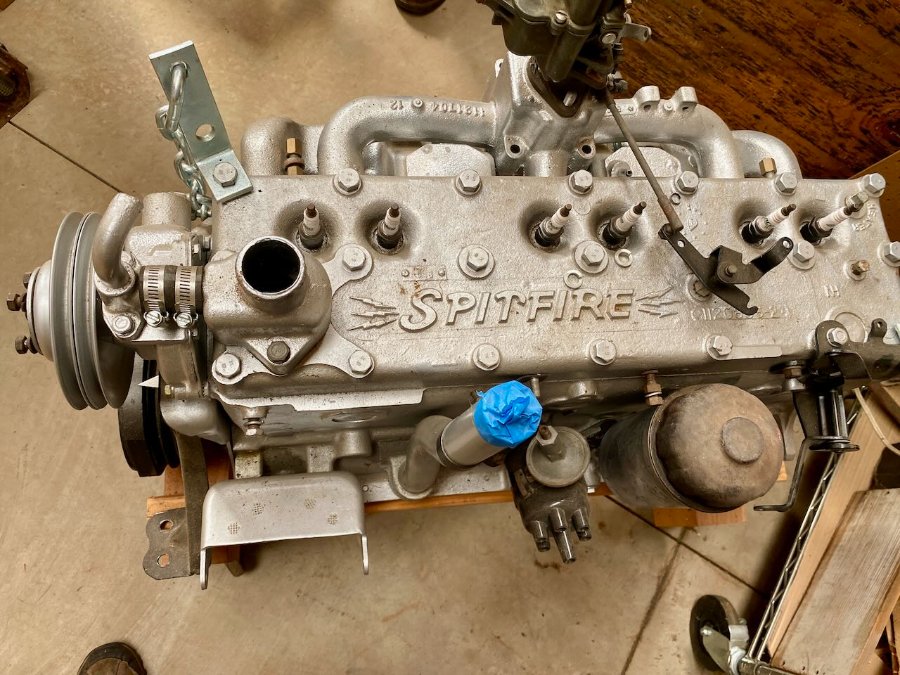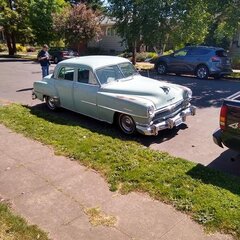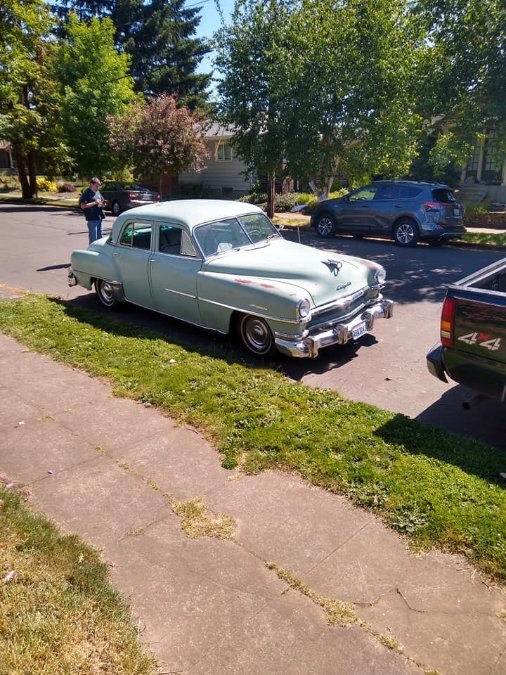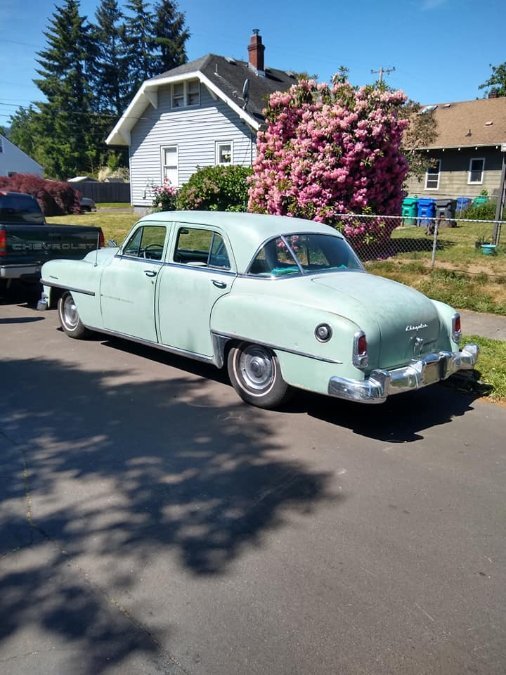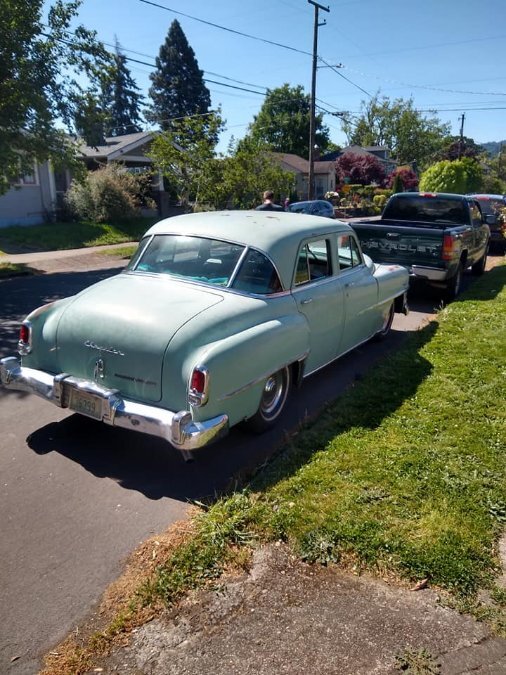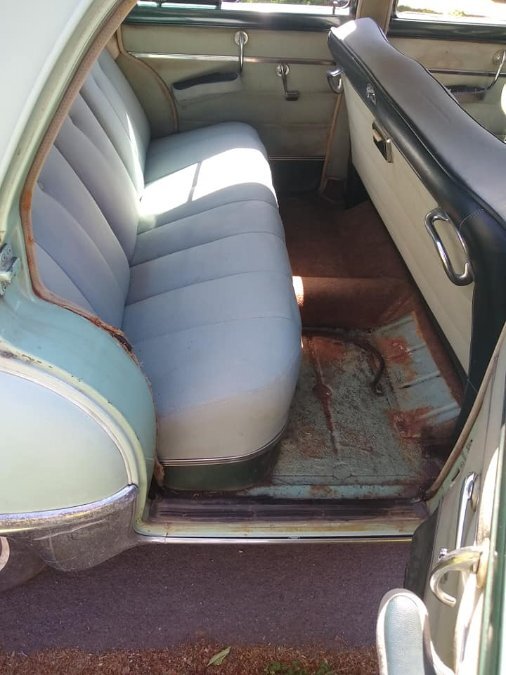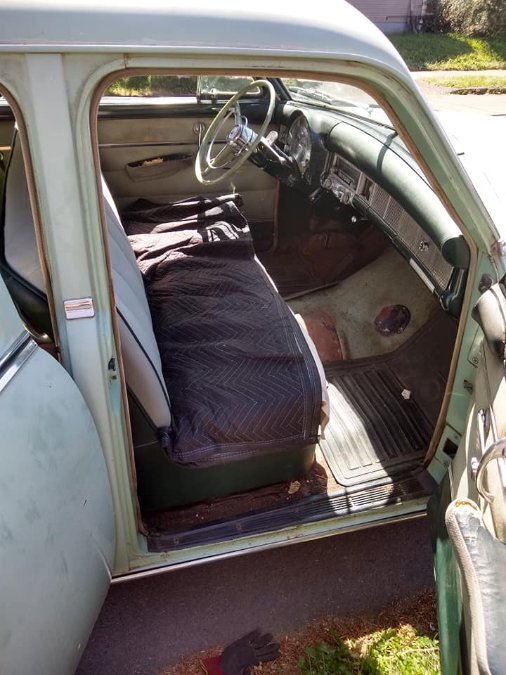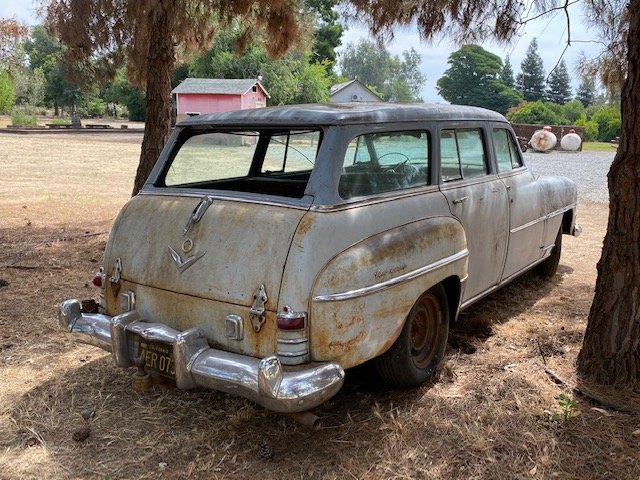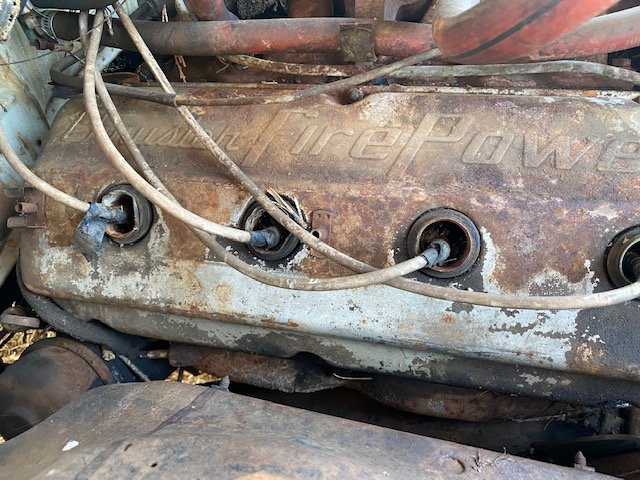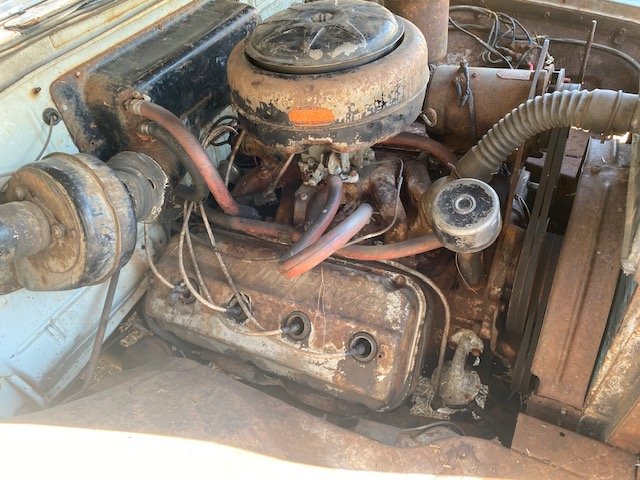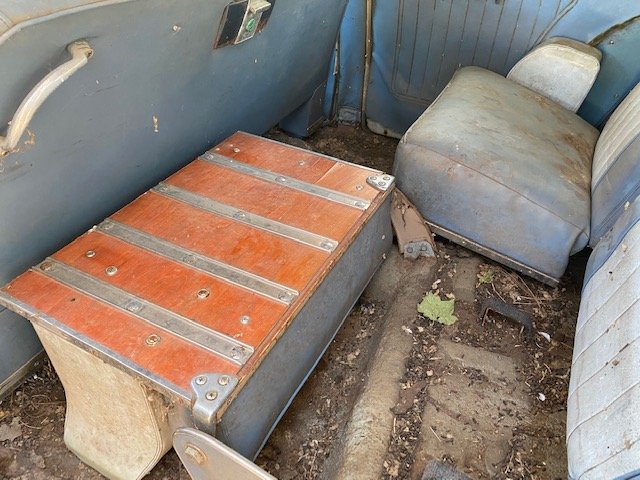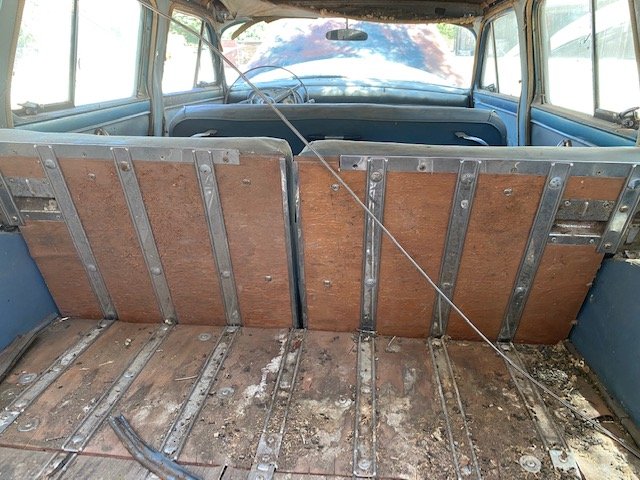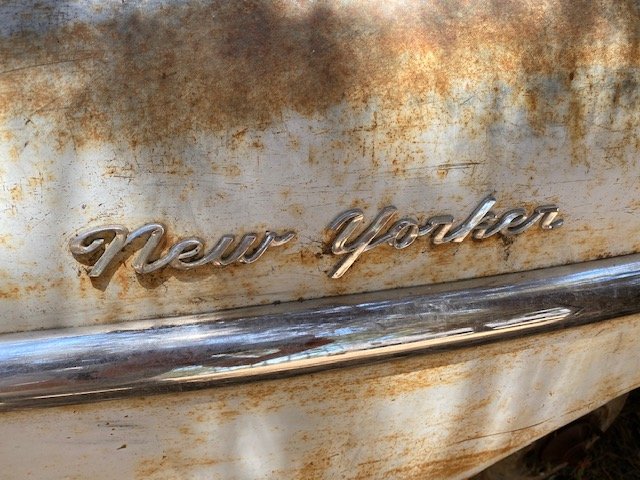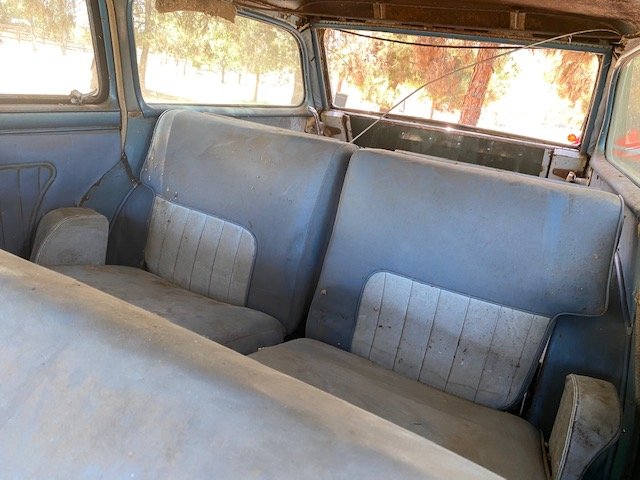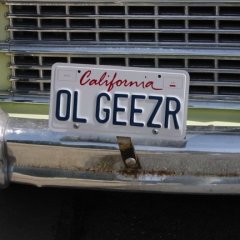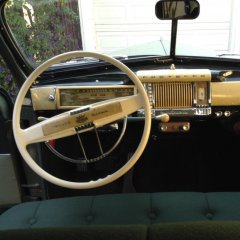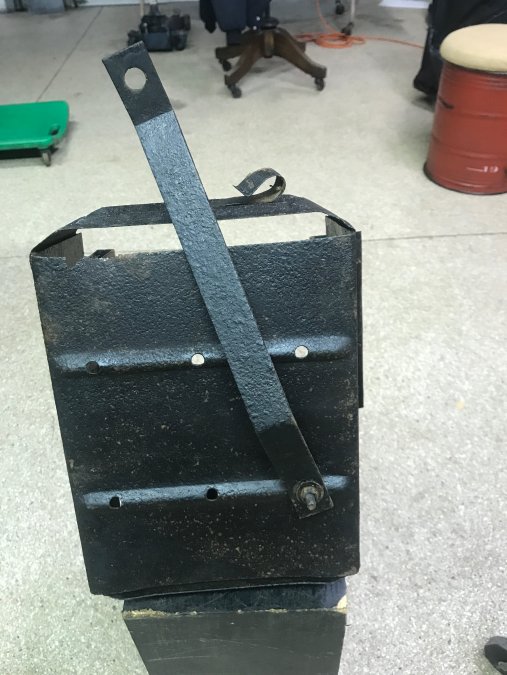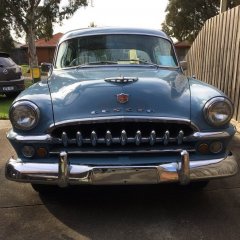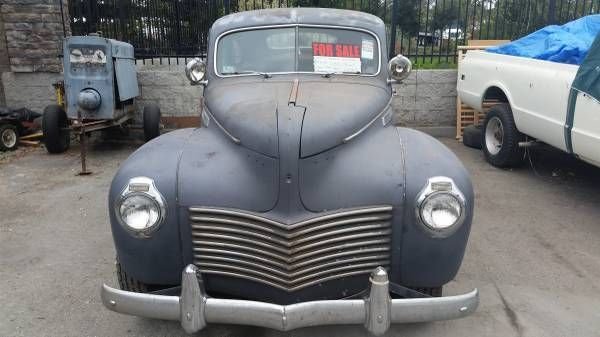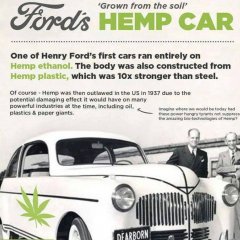Search the Community
Showing results for tags 'Chrysler'.
-
I have the opportunity to purchase a rebuilt C54 Chrysler Spitfire 265 motor from a friend at a very good price. I was looking for a powerplant for my stalled '52 Suburban project and after some research and help from Forum members, I think I can fit it into the wagon with only minor modifications. I have the bill of sale from the machine shop and it looks like they did a thorough job: They magna-fluxed and hot-tanked the block, resurfaced the head, installed new valve guides & lifters, rebored and honed .030 over cylinders. Installed new 030 over pistons and rings, reconditioned the rods with new pins and bushings, ground and polished the crankshaft, installed new rod and main bearings. Fitted new cam bearings, and installed a new oil pump. They then reassembled the long block. Costs were: parts $203, labor $890, total $1109. The year was 2003! In one of his excellent videos, @keithb7 states that rebuilding a Mopar flathead, parts alone will run you about $500/cylinder. I can testify to that price range, as I have a 230 motor in a local machine shop for hot tanking and magna-fluxing. They quoted me $5,000 to rebuild it and 6-9 months to get it done! I will be able to purchase the Spitfire for less than the cost of the original rebuild so obviously, I MUST BUY IT! I'm excited about resurrecting the motor, but not sure how to proceed. It was never run, and has been in dry storage for almost 20 years. I know - Marvel Mystery oil in the cylinders and using a drill in the the oil pump shaft to lube the bottom end - should I use standard 10-40w with an additive like Lucas TB Zinc-Plus for break in oil? Any other cautions/suggestions?
-
Hello In the forum, you have a good experience on straight height motor so if you could help me, it will be wonderful. i restore a Chrysler convertible Town and country 1946 but I have not the carburetor Stromberg initially mounted , I think to take a Carter 1bbl with adaptator but I have also to take all the other parts air filter, dashpot, …, could you help me to do the best choice with the picture of manifold attached thanks domi
-
I picked up this 52 Windsor deluxe about 8 months ago. cars mostly complete but unfortunately was blinded by the pure awesomeness of the car that I overlooked some glaring issues Car smokes terrible to the point its embarrassing, transmission doesn't want to shift after being driven for more then 10 minutes. pervious owner had stated the brake lights stopped working when he added brake fluid turns out it was because the brake light bulbs were missing. I've done little work to the car just replaced the shocks and added headlight and brake light bulbs and bought a carpet kit and cowl vent seal. enough ranting onto the questions. I was quoted about 4.5k to rebuild the motor(265) complete top to bottom not sure if that's reasonable I cant seem to find rebuild kits to get a idea. the car has a lot of body roll when corning not sure if that's normal for a car of this era. was looking for a replacement gas tank as someone had previously "restored" the gas tank then drilled a whole in the top to run fuel line, seen several options but wasn't sure what one was a direct swap. I was spit balling the idea if the rebuild costs to much that i would just buy a donor mustang gt and take its guts and turn the Windsor into a cruiser. If anyone's done anything like that I would appreciate a reply.(any reply is appreciated)?
-
Inspired by @Worden18 and his Meadowbrook thread , I decided that I will host a thread of my 1953 Chrysler Windsor Deluxe this season. I was thinking about why I wanted to do this. Why share my year of travels and interactions in my old Mopar on the internet? I think there are several good reasons. None really more important than any other. Arguably it could summed up as just plain cool. It feels good to know that here at P15-D24, there are many others who share my passion for the old Mopars. We have a lot in common. We have lots to share. The good folks here care about keeping these old cars running and out on the roads. And if like me, enjoy reading other's adventures. Seeing the sites in another part of the world is fun. Every photo tells a thousand words. I hope there will be lots to show and tell this coming season. I also want to give back a little to this forum. The help I found here is much appreciated. Maybe I can repay you folks a little by giving you a little entertainment. Here we go.... My car season is anxiously beginning as temps are forecasted to hit 17C (62F) over the next few days. That'll kick start the big snow melt. My Chrysler is ready to cruise now after a busy winter. We sold our home and moved in the middle of my planned winter car repair schedule. Then we went on a 10 day trip to a much warmer climate. Since I got back home and settled, I've been busting my knuckles getting everything I wanted done to the car before the April 1 deadline. That's when Vintage Car Club Parade is. I'm not sure who's more excited. My 19 yr old son or I, for the cruising season. He's almost found daily out in the garage, sitting in the car making vroom- vroom noises. "Feeling the new brakes and clutch pedal adjustments", he says. Tonight my car is jockey'd up in the garage ready to get out. Hopefully the snow on the sides of the roads get knocked back enough this weekend to keep water off the pavement. Then it's go time. Cruising 2018 is but just around the bend here.
-
Well, I did not need another project, but this was too nice to go to the scrapper. A friend told me about an old Chrysler wagon with a hemi, that had been sitting in the same spot for 39 years, up in the mountains of northern CA, about 3 hours from my house. I talked with the owner, a nice fellow, a lumberjack, sawmill owner who used it for his business in the 70's and in 1981, parked it when it began to smoke and drip oil a bit. He covered it up, and although the snow caved the roof in a bit here and there, everything else is in remarkable shape, even for a California car. It is a 1954 New Yorker Town and Country wagon on a 125 in wheelbase. It has the last big old-style hemi- the 331 cu in motor with the 2 bbl Carter carb making 195 hp. If you swap it out for a 4 bbl Carter, it jumps to 235 hp. It has the Powerflite 2 speed auto trans and power steering. There is one small rust spot under the driver's foot area, but the frame, floors, rockers, etc and all solid. I may switch horses here, shift concentrating on the '52 Plymouth Suburban, and begin restoring this one, as it will hold the grandkids and make a great, comfortable cruiser. I need to find some folks who have restored Chrysler wagons, to see where the pain points are.?. So much fun!
- 60 replies
-
- 4
-

-
- town and country
- hemi
-
(and 3 more)
Tagged with:
-
Debating front coil spring replacement. Do I know anything about springs? NO! Lots of reading on the subject, and that the Aerostar springs are good for old Mopar. And multiple results as to the resulting car height they provide.The spring is shorter than original, but gives same height? Cars mentioned are Dodge, Plymouth and DeSoto. Mine is '49 Chrysler. So far lots of stuff about this '49 are different from other Mopars. So it makes me want to question springs. Stock 250 engine. Any wisdom from the been there - done that experience would be appreciated. Prices for the CC850 spring seem reasonable. Installing them is another story. Thanks.
-
Hi Mopar fans Once again ? I would like your advice ! On my Chrysler New Yorker 1953 V8 Fluid drive I have a Carburetor carter wcd 935s. It was "rebuit" with appropriate kit, but after this winter, it works very bad (too rich and hard to tune up ) I have found a New one ( rare ) But it's a 931 SC ! someone know the difference between 935s and 931sc and if 931sc will fit my NY 53 ? Thanks a lot from Belgium
- 2 replies
-
- 1953
- new yorker
-
(and 1 more)
Tagged with:
-
I'm trying to find a stock type oem muffler to replace the one on my 48 Chrysler New Yorker 8 cylinder (which I believe, is longer than the 6 cyl model). That would be the larger front one, as they came with a front and rear (mine only has the front). I want to replace it with a quiet oem type, no Flowmasters, Smitty's etc.... When I say oem type, I don't mean an actual NOS oem; I mean a new muffler in the oem style. If anyone has a older cross reference guide, could you post it on line? My current muffler has the following markings on it, but no brand name: T 777 and W 757 659. I've searched the web with those numbers, but nothing comes up. Thanks, David in Santa Cruz Below are the specs for my muffler, the dimensions are approximate: total length 38" body length 34" circumference 19 1/8" cross section 8 inlet num + location = 1 center outlet num + location = 1 Rt. side inlet pipe diam 2.38 (outside measurements) outlet pip diam 2.18 " " muffler shape oval
- 5 replies
-
- oem muffler
- chrysler
-
(and 3 more)
Tagged with:
-
I just wanted to share the latest problem so that others could benefit from my stupidity experience. I had been chasing a performance problem for a couple of months which had prevented me from driving my 1941 Chrysler New Yorker very often. It had a moderately rough idle, difficult hot-starting, a bad stumble when coming off idle once it was warm, and it kept getting worse over time. It had started stalling when coming off idle once in a while. These fluid drive cars with the throttle guard are supposed to be impossible to stall, so that was the final straw. I had been avoiding driving it because of the lack of power when taking off from traffic lights -- couldn't guarantee it would actually go. I tried a lot of different things -- initially I worked on plugs and timing, cleaning plugs which were still relatively low miles, but admittedly 10 years old and had minor fouling. Tweaked the timing to try to advance it to get a little more power -- that just made it tough to start. Cleaned and re-gapped points, which seemed like they should still have plenty of life left in the wear block and the points dressed up nicely. Nope. Checked fuel system to see if was starving for fuel in coming off of idle. Had to run the idle speed a bit high to keep it from stalling, and it required a lot of nursing the throttle while stopped in traffic. I had replaced the fuel tank over the winter, mostly because the drain plug had been frozen in place forever, yet it dripped pretty steadily ... And the tank was not in terrible shape, but I could really never properly drain it easily, and it was pretty nasty on the outside, with some minor dirty stuff on the inside. Replaced scungy fuel line; replaced old fuel filter, realized I was doing the glass bowl fuel filter wrong; re-installed fuel filter; checked the carb, which had only a small amount of sediment in the bowl, but I had thought that a clogged accelerator pump circuit could have been the source of the stumble. Even though I could visually see that the accelerator pump was giving a squirt. Nope, that wasn't it either. Carb is now very nice, but tuning the (2bbl) carb with the idle mix screws was puzzlingly not responsive. Was it fuel flow problem? Did the new gas cap I got (after I left one on the pump last year after a fill-up) vent properly (i.e. prevent a vacuum in the tank from working against the fuel pump)? Nope, gas cap is properly vented for vacuum. Gas caps taste pretty nasty, too. Fuel bowl level? Nope. Checked distributor some more. Free play acceptable. Cleaned vacuum advance, it was basically working, if dirty, and the diaphragm was sound and the spring good. Mechanical advance was basically within spec using a timing light. Distributor slightly dirty inside. Condenser checked out okay with a multimeter. It's about 300 nF, for those who want to know. Finally went to poke around more with timing and I said to myself, "You know, self, what do you really know about that ignition coil? How long's that been in there?" and I figured I didn't have much to lose checking that out. It does require crawling under the dash to get the coil out, because it's got one of those coils through the firewall with the ignition lead to the coil primary on the back side of the coil inside the car. So I pulled that out, and put the coil on the bench with the voltmeter, and it looked "funny". The primary read unsteadily at between 0.3 and 1.3 ohms, rather than a steady value somewhere around 1.5 ohms. The primary-to-secondary resistance was not the expected 7000 - 10,000 ohms, either. It was mega-ohms or open-circuit. It wasn't really a definitive answer that the coil was bad -- I mean I had checked spark previously, and while it might have been intermittent or missing a bit, it still put out a basically good spark, I thought. One of those cheap spark-gap checkers is a nice tool instead of zapping yourself by holding the lead near the engine block. But the local auto parts joint had a 6 volt coil in stock for only $20, so I figured I may as well just check that out, for all the time I'd been dumping into this. It required a little gimcrackery to get the ignition lead to the front of the coil in the engine bay. But it just fired right up and I could not believe how smooth the idle sounded. Quick check to tweak the timing back to TDC. I let it warm up for several minutes, come off the fast idle cam on the choke, and it runs much nicer now. Drove it for a half-hour on a warm day, and it just pounces off the idle now. Whole different car, seriously. Drove it straight up the hill that has the stop sign in the middle of it and no hesitation or stumble now. Where did all this power come from? It's still a heavy car and underpowered by modern standards, but it drove like I remember it running. Practically leaps off the line. Finally. Now re-check the carb tune, and it is very much more responsive to carb adjustment, and the idle speed can be adjusted all the way down to the 500 rpm given in the manual without any trouble. What's the moral of the story? Well, "99% of carburetor problems are electrical," that's for sure. And the coil check was simple, but the annoying firewall installation of the coil discouraged me from checking it earlier. Have to stop getting suckered into checking and fixing things just because they're easy and accessible. I think I'd do almost anything to avoid crawling under the dash. And I also should have trusted my ear when it was telling me that it was missing intermittently (and not on any one cylinder). Smooth running is a good thing to pay attention to. But also, I want to thank the forum for being here and full of questions and for the people who have the good sense to answer "Just keep at it, you'll figure it out. Track it down, these cars aren't rocket science." Of course, I went down some blind alleys based on irrelevant questions... Now I have to make the coil install look a little prettier. There are a few people on the web who have the original style 6 volt coils with the primary lead on the back, but boy, do they want serious money for them. Cheapest I saw was $140, and it's NOS, so who knows how sound it is and how long it'll last? Others want $200. I'm gonna stay with the off-the-rack coil, I reckon.
-
Having some difficulty setting my timing using a vacuum gauge on my 48 New Yorker 8 cyl…..and could use some guidance. I’m trying to find the timing “sweet spot” rather than just rely on the book specs. I’ve attached my vac gauge to a non-ported vac source at the carb base…(it usually reads about 17-18”)… then adjust my idle as low as I can get it…about 350 rpm or so….to keep the mechanical advance from kicking in. Did not disconnect vacuum advance because it is not supposed to activate at low RPM. Next, the procedure is to advance the timing until you get the highest rpm...just before it drops of. The problem is the more I advance, the more RPM I get…until I can’t turn the distributor any further (about 12-15 degrees (which I know is way too far). What should happen, is that at some, point the RPM should decline when the timing is too far advanced…but it doesn’t. I would expect the RPM “fall off” to show excessive advance, but that’s not happening….(FYI, points are set to specs and read about 28 degrees of dwell). The manual calls for 2 degrees ATDC, but with modern fuels I’ve been told most people run about about 2-4 degrees advance; I’m currently at 2 degrees BTDC based on my timing light. Can anyone tell me what’s going on?
- 7 replies
-
- new yorker
- timing
-
(and 3 more)
Tagged with:
-
Bought me a 1950 Chrysler Windsor with the spitfire 6 in it. Got it yesterday and first gear and reverse work. I think 2nd and 3rd are linked wrong. The man I bought it from said his brother messed with the linkages and got them messed up. Since I’ve never had any experience with a 1950 Chrysler and this is my first time I need outside help on locating, diagnosing and fixing the problem so I can get this beauty out on the road! (PS- he said all the gears worked and he drove it 2 months ago up until his brother messed with it) also general knowledge and things to look out for with this motor would be appreciated as well! Thank you!
- 4 replies
-
- spitfire
- spitfire engine
-
(and 2 more)
Tagged with:
-
So here’s what’s going on. On my Chrysler I like to get better highway gears. I came across a 1960 Plymouth fury rear axle. Was hoping to drop it in but after some research I don’t think I can as my axle is 60” 5x4.5 and my leaf spring mounts would be 47 where the fury is 55.5” 5x4 and spring mounts is 45.5? so this leads me to is could I take the gears from the fury and put into my axle?
-
Hello again everyone. My brother and I have been working on pulling out the motor/trans because we believe the ring gear on the flywheel went. I currently have a 265ci long block in the car. I want to rebuild it because oil pressure is like 5 psi idling and 25 on the hwy. I found on kijiji a 23 with trans for 500 that was rebuilt in 1995. It showed 40-50 psi in a video while it was idling (warm I’m assuming by the temp gauge next to it) is this too high for idling? anyways getting to the point. I would like to get that 230 as a replacement till I can afford to rebuild the 265 however looking at the motor mounts i don’t see anything modified to fit the 265. I was under the impression it had a 23 block before and they have to squeeze that long block in. Did is my car come with a 23 or 25 block? Attached is is the motor and mounts
-
Hello everyone..new to the forum. Will be taking ownership of my first oldie this next weekend, a 1953 Chrysler New Yorker. Looking forward to learning from this group.. thanks Terry
- 5 replies
-
- 1
-

-
- 1953
- new yorker
-
(and 1 more)
Tagged with:
-
Hello, I am wondering about the correct application and location for this bracket on my 1938 chrysler royal. It was attached to the bottom side of my battery box on one side and the other does not seem to line up with anything?/? I does not line up with anything obvious battery hold down ect...?/? Any help Thoughts would be appreciated...
-
My mate John took me for a ride in his 1938 Chrysler Royal last Sunday. Beautiful car and runs great. See the youtube video.
-
Here are some photos of John's Royal. Steering wheel is ok, we are in Australia. https://postimg.org/image/dkiinj0fp/ https://postimg.org/image/4s1jzufat/ https://postimg.org/image/4e0808v79/
-
With my chrysler i have a couple small complaints in terms of its looks. I feel the rear tail lights are too small for how big thr back is (any suggestions on bigger lights will be nice) bumpers stick too far out but my biggest beef is the grill. The whole car is curves and i love it. To me it screams aerodynamic (might not actually be the case but the body lines makes sense to me) what doesnt make sense to me is the rectangular grill. Everything is curves then boom lets make a straight grill. What i love to know is, can a 1941 plymouth grill/front face be switched out? I love the look of the 41 plymouth I go for a 1939 plymouth but those square lights....
-
Ok so I have a few questions. I've never owned, dealt, etc. anything mopar. My wife and I have acquired her great grandparents 46-48 Chrysler Windsor Club coupe, 5 window, 2 door. I'm not sure how to tell the year, just been judging from google images. The car has the spitfire flathead six with fluid drive. The car has been sitting for 50+ years. Floor boards are gone along with rust in other places. We've pretty much decided that it's more project than we want but I don't know if it's a car that there's a market for, or if there's any money in parting it out, or just haul it to the scrap yard. Thanks for any advice in advance. Clayton.
-
Hello, first off let me say a pre thank you to anyone who takes an interest or provides me with any kind of insight. I have for years been cruising automotive forums whenever my vehicles have started acting up. i have found a wealth of information and helpfulness to pretty much diagnose, if not fix almost every problem. So far, so good...sort of. Anyway i have never signed up for any forum before and was content to just scout as a guest. Well. Last November I fulfilled a boyhood fantasy and bought a vintage pick up. I have since, been learning( almost daily it seems) about the joys of owning such a piece of history. I thought it was time to sign up, while looking through this forum the first picture i happen across was a 49 Fargo 1/2 ton...just like mine. i have since speculated mine to be a 50/51 as looking at pictures mine has the later grill, although the registration is 49. though the engine does have a tag that say " remanufactured by the chrysler method" and is dated 1956. Ok, so i have had a pretty lovely intoduction to vintage vehicles thus far. 3 weeks after purchase my head gasket went( the first time). Sad fargo sat for a month while i discovered how much fun it was to find parts for a 25 inch canadian made chrysler 251 flathead 6. Thank you vintagepowerwagons.com. After pulling the head off and discovering the cooling systems was for lack of a better word, Hooped. i set about gathering a new water pump, hoses, gasket set, APR head studs, rotor, cap, plugs, coil, leads,oil, etc. I had the rad flushed, had the head planed and magnafluxed, cleaned the water distribution tube, wire wheeled the top of the block and pistons. blew out all the water out of the intake. got all the crud out ( at least i thought). cleaned up the carb as best i could( so not a carb guy), rebuilt the distributor( ok my dad did) So, old motor, no idea how long it had been like that. Head gasket replacement, to be expected right. ya. ive heard these flatties will blow a gasket from time to time. no worries, i installed studs so a head replacement is no biggie... ok im getting to the point. so my head gasket has gone twice now, and im suspecting its going again. just before the second time, it started making this weird flapping noise, which kinda matches the rpms and then it just gets kinda slower. at first there is no loss of power, then it definitely does. I shut it off before anything came gushing out the tail pipe, as i don't want the rods to hydraulic. First, does anyone know what this noise is? and is there something i can do to help eliminate the possibility of blowing another gasket. Could it be the timing. As it is hard to set by gun, I've been told to "listen" for it. Second, as its like 3 head gaskets in like realistically 3 months, am i fighting a losing battle here. granted there are lots of determining factors , but I've combed through a lot of reading and have tried a lot of things to get it fixed. Don't get me wrong, it runs great when it runs.
- 30 replies
-
Mark Duggan and I are continuing to beat our heads against the wall, trying to find an event that will motivate interest in a gathering of Forum members and Chrysler Corporation Vehicle enthusiasts. We would also be tenatively gathering at Mark D's place out side of Worchester, Ma and doing a group drive to the event area. Last year we did a tour of the Hudson Valley in August. This year an opportunity presents for September 13-16 in the form of the Walter P Chrysler Club's annual meet. The WPC is a club for all Chrysler brands from the earliest models to the present offerings. This year they will meet in Belfast,Maine. There are activities planned as well as self directed tours and visits to local attractions. The Participant Judged Show is held on Saturday, all makes of Chrysler cars and trucks are welcomed regardless of condition. One does not have to be a club member to participate. At this time we are considering letting a house in the area that will accomodate up to 12 people. It features a pool and hot tub, canoes and kayaks, fishing gear, and is walking distance to shops restaurants, parks and beaches. We are looking for a commitment of 5 to 6 parties (have 3 currently) to make this work $$$ wise versus the host Hotel costs This would give us a place gather, sleep, cook meals, and also give the folks not interested in car stuff all the time a place to be rather than in the hotel room or lobby. Link to house: https://www.homeaway.com/vacation-rental/p391622 Link to WPC click on 2016 meet: https://www.chryslerclub.org/meetinfo.htm Times are good gas is cheap bring grab your Chrysler and your juke box money and come on out.
-
The ol' buggy has been immobile, waiting for a repair on the starter. How boring, just sitting out there in the driveway with nice summer weather. A project was on the list. Why not now? Via the picture, many of you well know this kind of project. I ran out and bought a compressor and spray gun.
-
Those infamous rubber sill plates, one of the first things you notice getting in the car. What condition were yours in? Mine were old, dry, hard, brittle, worn, cracked and just plain nasty. And that one piece construction with the rubber molded directly to that metal strip creates rust underneath. With those pins on the metal going into the rubber grommets in the rocker, it was a handy way to attach them. Being SOOOO ugly, those were one of the first things I removed on the 4 door. Each one also had 2 screws, lucky to get those out without drilling. And the rubber grommets came out. Next to attack the rust, then prime and paint. It's not visible, slop on any color you got. I had Rustoleum Black. Now you've got a 'clean' rocker panel with big holes in it. Better than looking at broken pieces of rubber and a rusty plate. While searching for other parts, original replacement sill plates popped up. And the price. WHOA. These were definately NOT going to be a part of my budget for parts, to put my feet on. Time to be clever for some kind of non-Chrysler replacement that would look nice and serve the purpose. Going non original is no problem. After much debate, I settled on using rubber floor mat material, which comes in an array of patterns. Frowned on the 'ribbed' design, which would be hard to clean, and catching lots of beach sand. A smooth surface would be more suitable, and a Diamond Plate design caught my eye. Searching got lucky, spotting this pattern in the necessary 36" width, 1/8" thick, and it was 40% off. Only needed a foot long (4 pc X 3" each). One piece was carefully cut straight, and put in place using a good adhesive, no screws. So far so good, it looked nice. Quite functional, but also quite plain. Something was missing. Ah, it was the boring match of the rubber to the carpet, which could be improved with a piece of trim, similar to the carpet-to-tile stuff. Had the right idea, but shopping wasn't finding anything 'exciting' to cover this seam. Finally settled that 3/4" width would be the best. Picked up a piece of aluminum, 36" X 1/8" X 3/4", cut to 32". Buffed that sucker out to a glossy shine. Now we're getting somewhere. Not done yet. How could I add some class to this stick of metal? A perfect idea came to mind, producing the intended touch of class. Take a look at the result of my effort with this piece of aluminum. The first of two finished pieces. It was difficult to get a good photo with the reflections. CHRYSLER is centered, and I wanted the raised (shiny) letters with an engraved background. This was done freehand using a Dremmel. Needed some practice first with various bits to obtain the result. Grinding is tricky. And a steady hand. Here it is installed, using stainless oval head screws. Perfect for the intended purpose. Do you like it? I think it's a classy addition to the '49.
-
File Name: 1949 CHRYSLER INSTRUMENT CLUSTER GASKET File Submitter: rb1949 File Submitted: 07 May 2016 File Category: Instructions, Manuals & Templates This is a PDF template for the one piece paper (fiber) gasket for the 4 gauges and odometer housing that mount to the rear of a 1949 Chrysler Instrument Cluster. I believe 1950 used the same cluster. Made to keep dirt, dust, etc. from getting into the gauges. Cut with a sharp instrument to avoid 'tearing' the material edges. Punch the screw holes slightly lager than the screw. Print the template at 100%. Click here to download this file


